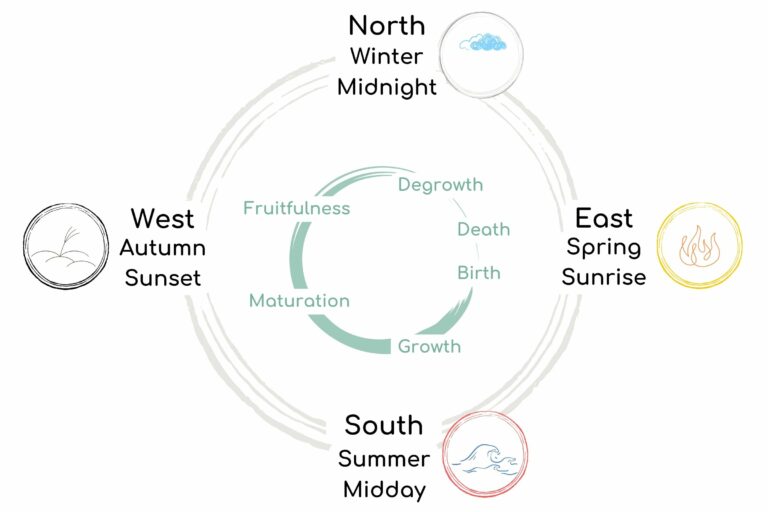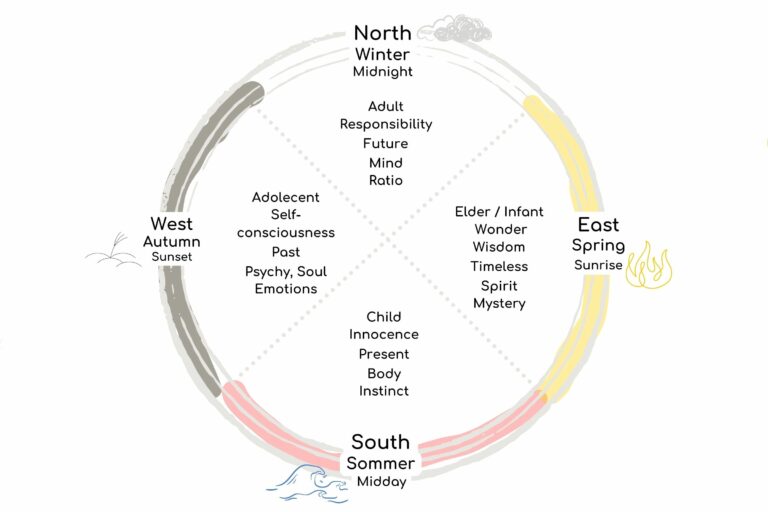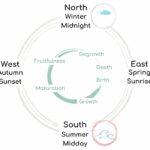Wild Coaching
What is the Four Shields Model of Balanced Personal Development?
The “Four Shields Wheel” is a cyclical nature-based model helping to understand and navigate change and transformation processes on the personal, organizational, and societal levels.
What is the Four Shields Wheel of personal development?
The Four Shields of human wholeness constitute a nature-based cyclical map helping to orient within different phases of human life – from childhood to elderhood -, phases of crisis, change and transformation, as well as in everyday life. It can help to understand in which phase of a natural development cycle one is and provide guidance on what are “the tasks” at hand.
By accepting the phase one is in and embodying what the phase calls for, one leans into the change process rather than using energy to resist it. By fully experiencing the present phase we create the foundation from which we naturally move into the next phase. Over time one learns to trust change, instead of struggling with it, which is the base for personal resilience and a balanced life.
Where does the Four Shields model I apply come from?
In general, the Four Shields model originates from the observation of transformation processes happening in nature. From immemorial times humans across the globe observed their environment: they noticed that all change processes follow similar patterns in a cyclical way. Many populations developed their own cyclical models (wheels) depicting the relationships between different elements and phases of transformation.
I learned about the four shields model during the wilderness-based rite of passage training I did at the School of Lost Borders and through the books of Bill Plotkin. In my work, I mainly apply the nature-based cyclical models of these two sources.
More details about the lineage and sources
The founders of the School of Lost Borders, Steven Foster and Meredith Little, learned about the rudiments of the Four Shields from North American Cheyenne tradition, as well as from similar models coming from Europe, North Africa and Asia. They kept developing the model and looking at how to apply it to the present Western context. In 1998 they published „The Four Shields: The Initiatory Seasons of Human Nature“. Eco-psychologist Bill Plotkin developed the Four Shields model further and created two detailed maps. The Eco-Soulcentric Development Wheel provides guidance on the phases of healthy, purpose-driven mature adults over the arch of a lifetime (it’s described in the book Nature and the Human Soul) and the Nature-based Map of the Human-Psyche provides guidance on how to cultivate our innate human wholeness and practice self-healing (it’s introduced in the book Wild Mind: A Field Guide to the Human Psyche).
What do the Four Shields stand for?
The four shields model overlays three characteristics influencing all living beings (the day-night cycle, the yearly cycle and the cardinal directions), it associates qualities experienced and expressed by animals, humans, plants, or ecosystems in the different phases and creates a way to display transitions between different phases of the natural cycle.

When we apply these cycles to the human experience, we can associate different life phases, levels of energy, ways of knowing, what our consciousness focuses on, types of love, types of fear responses, and time perceptions to the four phases. Below there are a few associations, but there are more of them. The model becomes really useful once we look at the relationship a person has with various aspects of a shield in their life and how different levels of expression or neglect of qualities associated with a shield create dynamics between shields.

How can the four shields model be applied to personal development?
When we have the impression that we are in balance, or in the flow, we move smoothly from one shield to the next. For instance, imagine I cook a nice dinner for my family (North: take responsibility, care for my people), as the food is ready before eating I stop for a moment and connect with a sense of gratitude and fascination for the food laying in my plate and the intricate net of life that brought it to me (West: connect to something bigger than oneself and to the mystery), I then start eating and enjoy the gorgeous taste of the food (South: be in the present, use the senses, be in the body), when the plate is empty I sense a sense of sadness that the enjoyment of the food is over, I maybe question if I eat too much (West: self-reflection, connect to the past, experience emotions related to the past), I then think of what to do next, stand up and clean the dishes (North: future-oriented, responsibility, order).
In this example, I move smoothly through phases of doing (North & South) and phases of being (East & West). I can experience the qualities related to the four shields on a small scale – like when I’m having a meal, but also on a middle (a month or a year) or macro scale (the arch of my life).
Mostly when we feel unsatisfied, stuck, or struggle with something in our lives, this can be associated with a lack of balance between the integration of characteristics related to each shield in our life. This happens for instance when we are most of the time in one/two shields or want to avoid experiencing characteristics related to some shields.
Let’s look at it through an example, of a very common behaviour pattern in our society, which you may know from your own life.
Imagine that a person is very focused on performing well at work and achieving great results. She cares a lot about her work, is very motivated and does a lot of things to make her projects happen successfully. Her work days fly by. Typically at 8 pm, she realizes that she was in front of the laptop the whole day and still did not finish what she planned to do! But by now she’s exhausted and demotivated to keep working. Enough! After the hard work, she has deserved to enjoy something: she orders a pizza online and sits on the couch with a beer to watch a silly movie. Finally, she can turn off her mind.
If a person keeps repeating such a cycle, in the long term she may run into trouble: she may feel increasingly disconnected from her own body and emotions, as well as from the people around her. Not feeling much, she may keep overstepping her own boundaries and start burning out. Also while she may seek more and more short-term gratifications (through food, alcohol, movies, sex, …), but not feel much enjoyment from it, she may develop an addictive behaviour and increasingly feel numb.
When applying the Four Shields Model to such a situation we could say that the person has developed well some characteristics of the North shield (planning, doing tasks, being responsible and well organized, etc.) and spends most of her time in that shield. When not working her desire is to move straightaway to the opposite shield of the South (being in the present, in the sensations of the body, experiencing joy), but the time spent there is not fully satisfying and as the intake of substances stops she quickly moves back to the mind-controlled North shield (maybe after a phase of self-judgement in the West).
In this case, the East and West shields are avoided/are underdeveloped (the person may have limiting beliefs related to the characteristics of these Shields or never learned to integrate them into her life). From a four-shield perspective, it would be recommended to start by developing characteristics of the East through practices like meditation, walks in nature, artistic expression, and unplanned time for just being. In the next phase, it would be recommended to develop more skills from the South (for instance by noticing physical sensations, being playful, dancing, having body touch) and then also more from the West (exploring limiting beliefs, fears, past woundings, deep longings, etc. ). This process would help to develop a more balanced, wholesome, expression of human nature.
Applying the four shields model in coaching
During the coaching I give I mostly apply the model of the four shields in an unexplicit way. As I hear about the behaviours and situations a person longs for and struggles with, I connect their experience with the change patterns of the four shields, ask questions to explore different fields, offer hypotheses about the origin of their struggles, check what resonates and offer ideas and exercises helping to cultivate and further develop shields that are not experienced in a healthy balanced way.
I also combine the “map” of the four shields with other coaching techniques and practices from my systemic-integrative background.
Are you curious to learn more about how to apply the four shields model to help you experience balance and flow in your life?
I’m happy to hear from you.




